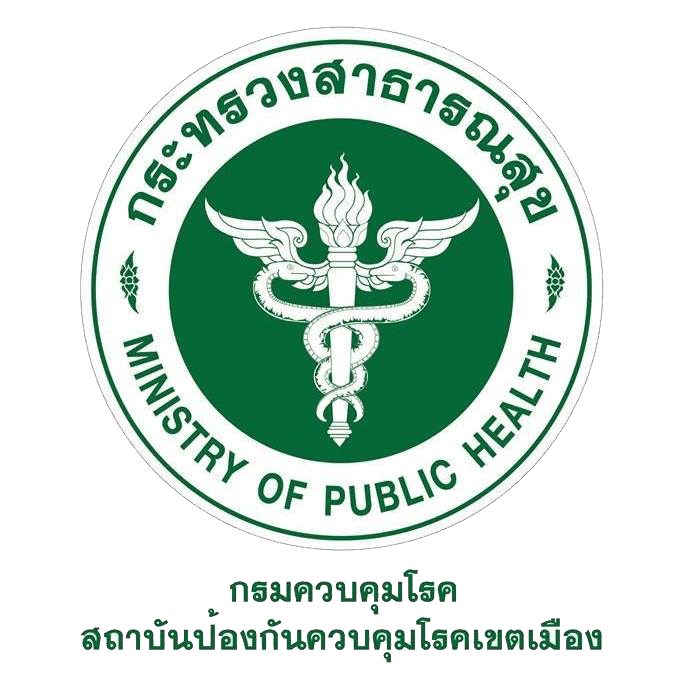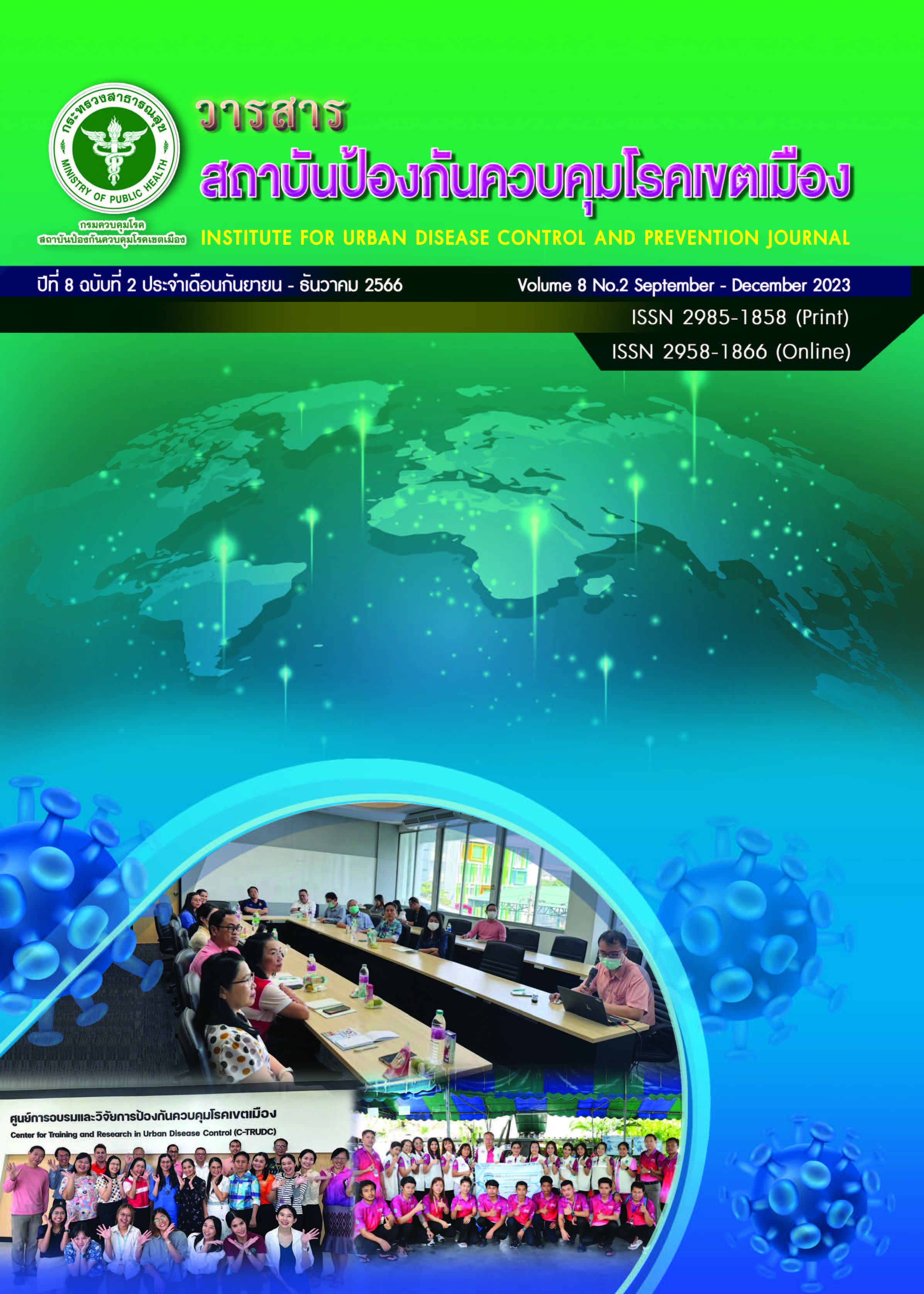การพัฒนารูปแบบการบริหารจัดการเพื่อป้องกันและควบคุมการระบาดของโรคติดเชื้อไวรัสโคโรนา 2019 ของแรงงานข้ามชาติที่อยู่ในแคมป์คนงานก่อสร้างขนาดกลางและใหญ่ในพื้นที่เขตเมือง กรณีศึกษา: เขตห้วยขวาง กรุงเทพมหานคร
Main Article Content
บทคัดย่อ
การวิจัยนี้มีวัตถุประสงค์เพื่อพัฒนารูปแบบการบริหารจัดการเพื่อป้องกันและควบคุมการระบาดของโรคติดเชื้อไวรัสโคโรนา 2019 ของแรงงานข้ามชาติที่อยู่ในแคมป์คนงานก่อสร้างในพื้นที่เขตเมือง ใช้ระเบียบวิจัยแบบผสมผสานทั้งเชิงปริมาณและเชิงคุณภาพโดยแบ่งออกเป็น 2 ระยะ คือ ระยะที่ 1 เป็นการศึกษาความพร้อมรับภาวะฉุกเฉินทางสาธารณสุขของศูนย์ปฏิบัติการควบคุมโรคเขตห้วยขวาง กรุงเทพมหานคร และระยะที่ 2 เป็นการศึกษาเพื่อพัฒนารูปแบบการบริหารจัดการเพื่อป้องกันและควบคุมโรคในภาวะฉุกเฉินสาธารณสุขของแรงงานข้ามชาติที่อยู่ในแคมป์คนงานก่อสร้างขนาดกลางและใหญ่ในพื้นที่เขตเมือง กลุ่มตัวอย่างประกอบด้วย คณะทำงานตามศูนย์ปฏิบัติการควบคุมโรคเขตห้วยขวาง บุคลากรสาธารณสุขศูนย์บริการสาธารณสุข 25 ห้วยขวาง หัวหน้าแคมป์คนงานก่อสร้าง เจ้าหน้าที่ความปลอดภัยหรือผู้รับผิดชอบงานอาชีวอนามัยแคมป์คนงานก่อสร้างขนาดกลางและใหญ่ โดยเลือกกลุ่มตัวอย่างเลือกแบบเฉพาะเจาะจง เครื่องมือที่ใช้ในการเก็บข้อมูล ได้แก่ แบบสอบถามและแบบสัมภาษณ์ รวบรวมข้อมูลโดยการสำรวจและการสัมภาษณ์ วิเคราะห์ข้อมูลเชิงปริมาณโดยใช้สถิติเบื้องต้นและวิเคราะห์ข้อมูลเชิงคุณภาพด้วยการวิเคราะห์เนื้อหา ผลการวิจัยพบว่า (1) ความพร้อมรับภาวะฉุกเฉินทางสาธารณสุขของศูนย์ปฏิบัติการควบคุมโรคเขตห้วยขวาง กรุงเทพมหานคร ภาพรวมมีความพร้อมระดับปานกลาง โดยด้านระบบข้อมูล ด้านข้อมูลสารสนเทศที่สำคัญ และการจัดการและการตอบโต้เหตุการณ์ ยังไม่มีความพร้อม (2) รูปแบบการบริหารจัดการเพื่อป้องกันและควบคุมโรคในภาวะฉุกเฉินสาธารณสุขของแรงงานข้ามชาติที่อยู่ในแคมป์คนงานก่อสร้างขนาดกลางและใหญ่ในพื้นที่เขตเมืองต้องมีโครงสร้างระบบบัญชาการเหตุการณ์ของศูนย์ปฏิบัติการควบคุมโรคเขต ประกอบไปด้วย (1) ผู้บัญชาการเหตุการณ์และรองผู้บัญชาการเหตุการณ์ (2) ส่วนปฏิบัติการ (3) ส่วนแผน (4) ส่วนสนับสนุน (5) ส่วนการเงินและบริหาร (6) ส่วนยุทธศาสตร์และวิชาการ และ (7) ส่วนสื่อสารความเสี่ยงเพื่อเป็นการเพิ่มประสิทธิภาพในการบริหารจัดการในการป้องกันและควบคุมโรค
ผลการวิจัยพบว่า (1) ความพร้อมรับภาวะฉุกเฉินทางสาธารณสุขของศูนย์ปฏิบัติการควบคุมโรคเขตห้วยขวาง กรุงเทพมหานคร ภาพรวมมีความพร้อมระดับปานกลาง โดยด้านระบบข้อมูล ด้านข้อมูลสารสนเทศที่สำคัญ และการจัดการและการตอบโต้เหตุการณ์ ยังไม่มีความพร้อม (2) รูปแบบการบริหารจัดการเพื่อป้องกันและควบคุมโรคในภาวะฉุกเฉินสาธารณสุขของแรงงานข้ามชาติที่อยู่ในแคมป์คนงานก่อสร้างขนาดกลางและใหญ่ในพื้นที่เขตเมืองต้องมีโครงสร้างระบบบัญชาการเหตุการณ์ของศูนย์ปฏิบัติการควบคุมโรคเขตประกอบไปด้วย (1) ผู้บัญชาการเหตุการณ์และรองผู้บัญชาการเหตุการณ์ (2) ส่วนปฏิบัติการ (3) ส่วนแผน (4) ส่วนสนับสนุน (5) ส่วนการเงินและบริหาร (6) ส่วนยุทธศาสตร์และวิชาการ และ (7) ส่วนสื่อสารความเสี่ยง เพื่อเป็นการเพิ่มประสิทธิภาพในการบริหารจัดการในการป้องกันและควบคุมโรค
Article Details

อนุญาตภายใต้เงื่อนไข Creative Commons Attribution-NonCommercial-NoDerivatives 4.0 International License.
บทความที่พิมพ์ในวารสารสถาบันป้องกันควบคุมโรคเขตเมือง ถือว่าเป็นผลงานวิชาการ งานวิจัยและวิเคราะห์ ตลอดจนเป็นความเห็นส่วนตัวของผู้เขียนเอง ไม่ใช่ความเห็นของสถาบันป้องกันควบคุมโรคเขตเมือง หรือคณะบรรณาธิการแต่ประการใด ผู้เขียนจำต้องรับผิดชอบต่อบทความของตน
เอกสารอ้างอิง
กระทรวงมหาดไทย, กรมป้องกันและบรรเทาสาธารณภัย. ระบบบัญชาการเหตุการณ์กับการจัดการในภาวะฉุกเฉินของประเทศไทย. สมุทรสาคร: บอร์น ทู บี พับลิชชิ่ง; 2559.
สถาบันการแพทย์ฉุกเฉินแห่งชาติ. คู่มือระบบบัญชาการเหตุการณ์ทางด้านการแพทย์และสาธารณสุขสำหรับการจัดการในภาวะสาธารณภัย/ภัยพิบัติ (Public Health Emergency Incident Command System: PHEICS). นนทบุรี: สถาบันการแพทย์ฉุกเฉินแห่งชาติ; 2559.
World Health Organization. Framework for a Public Health Emergency Operations Centre. Geneva: World Health Organization; 2015.
องค์การอนามัยโลกประจำประเทศไทย. การทบทวนร่วมระหว่างการปฏิบัติงานด้านสาธารณสุข เพื่อตอบสนองต่อสถานการณ์โรคโควิด 19 ในประเทศไทย. 20-24 กรกฏาคม 2563: กระทรวงสาธารณสุข; นนทบุรี: กระทรวงสาธารณสุข; 2563.
Migrant working group [อินเตอร์เน็ต]. กรุงเทพฯ: เครือข่ายองค์กรด้านประชากรข้ามชาติ; c2021. รายงานสถานการณ์แรงงานข้ามชาติภายใต้การแพร่ระบาดและมาตรการควบคุมโควิด 19 เฉพาะพื้นที่จังหวัดสมุทรสาคร ระหว่างวันที่ 19 ธันวาคม 2563 – 31 มีนาคม 2564; 2564 [เข้าถึงเมื่อ 17 สิงหาคม 2566]; [ประมาณ 14 น.]. เข้าถึงได้จาก: https://mwgthailand.org/th/press/1619664113
ชญาลักษณ์ สิริภักดีกาญจน์. บทบาทพยาบาลในระบบบัญชาการเหตุการณ์ภาวะภัยพิบัต. วารสารพยาบาลทหารบก. 2561;19(2):70-8.
ชาญเลขา กุลละวณิชย์. การพัฒนากลยุทธ์การบริหารจัดการภาวะฉุกเฉินทางสาธารณสุขด้าน การป้องกันควบคุมโรคติดเชื้อไวรัสโคโรนา 2019 จังหวัดฉะเชิงเทรา. วารสารสมาคมเวชศาสตร์ป้องกันแห่งประเทศไทย. 2564;11(2):218-38.
กรมควบคุมโรค [อินเตอร์เน็ต]. นนทบุรี: กรมควบคุมโรค; c2020. แบบเก็บข้อมูลพื้นฐาน เพื่อการวางแผนการพัฒนาศูนย์ปฏิบัติการภาวะฉุกเฉิน สำหรับหน่วยงานสาธารณสุขระดับจังหวัด และระดับเขต (EOC Assessment Tool); 2563 [เข้าถึงเมื่อ 17 สิงหาคม 2566]; [ประมาณ 55 หน้า]. เข้าถึงได้จาก: https://ddc.moph.go.th/uploads/ckeditor2/ddce/files/EOC_Assessment_Too.pdf
สำนักงานเขตห้วยขวาง [อินเทอร์เน็ต]. กรุงเทพมหานคร: สำนักงานเขตห้วยขวาง; c2022. ข้อมูลทั่วไปในพื้นที่; 2565 [เข้าถึงเมื่อ 17 สิงหาคม 2566]; [ประมาณ 1 น.]. เข้าถึงได้จาก: https://webportal.bangkok.go.th/huaikhwang/page/sub/869
Freedman AM, Mindlin M, Morley C, Griffin M, Wooten W, Miner K. Addressing the gap between public health emergency planning and incident response: Lessons learned from the 2009 H1N1 outbreak in San Diego County. Disaster Health. 2013;1(1):13-22.


